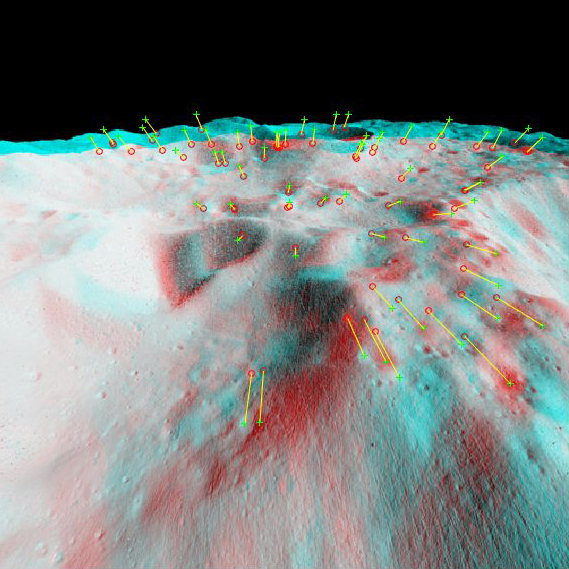Carnegie Mellon Students Will Flight Test Sensor Package Designed To Model Surface Pits on Moon and Mars NASA-Funded Rocket Flights Slated for Mojave Air and Space Port
Byron SpiceThursday, March 5, 2015Print this page.

A team of Carnegie Mellon University undergraduates is heading to California's Mojave Desert this spring to flight test a sensor package they developed for analyzing large pits in the surface of the moon or Mars.
The flight tests will be conducted aboard a reusable vertical-takeoff, vertical-landing XA-0.1-B rocket, called "Xombie," built and operated by Masten Space Systems. The three flights — two tethered and one free flight — will take place at the Mojave Air and Space Port, and are funded through the Undergraduate Student Instrument Program (USIP) of NASA's Science Mission Directorate and the Flight Opportunities Program of NASA's Space Technology Mission Directorate.
The hardware and software package the students developed would be used for a robotic lunar mission to the Lacus Mortis region of the moon planned by Astrobotic Technology and Carnegie Mellon. Orbital imaging suggests this region contains a pit — also known as a skylight — that may serve as an entrance to a cave.
As the landing craft flies over the pit, the sensor package would use computer vision to build a 3-D model of the depression. Upon landing, a CMU-developed robot, called Andy, would then explore the pit.
"This would be our first close-up look at a pit," said Neal Bhasin, a senior majoring in computer science who led the development team. Though the moon is covered by impact craters, the existence of numerous pits was discovered only a few years ago by orbiting spacecraft. "We want to see if we can model the pit walls well enough to find cave openings," he added.
Pits are also abundant on Mars where, at their lowest depths, they may harbor signs of prior life that haven't been detected to date on the planet's surface.
The students have tested their computer vision technology in CMU labs and in flight using a helicopter flying in the vicinity of Zelienople, Pa. The flight test aboard Xombie will more closely approximate the flight of Astrobotic's Griffin landing craft during its final approach to the moon — a powered rocket descent. At the Mojave site, a circle of shipping crates will be used to mimic the lunar pit.
William "Red" Whittaker, professor of robotics and supervisor of the student team, said NASA's USIP has launched many student payloads aboard sounding rockets or beneath balloons, but securing a flight using a vertical-takeoff, vertical-landing rocket such as Xombie is unprecedented.
"I'm immensely proud of the team and of its technical accomplishments," Whittaker said. "It's an amazing achievement from such a young group. Apollo included a lot of 20-somethings. Youth generates a lot of innovation and energy."
In addition to Bhasin, the team includes Kerry Snyder, a senior computer science and robotics major; Oliver Daids, a sophomore computer science major; Rick Shanor, a senior in mechanical engineering and robotics; Ashrith Balakumar, a sophomore mechanical engineering major; and Edward Nolan and Brent Strysko, both seniors majoring in electrical and computer engineering. Kevin Peterson, Astrobotic's chief technology officer, has mentored the team.
The importance of the sensors to the Astrobotic/CMU mission "is huge, immense," Whittaker said. Not only will the 3-D models of the pit provide guidance for the Andy rover, they will give scientists information about pits that couldn't be obtained from orbit. Planetary scientists, vulcanologists and other scientists will be able to use that precious information to obtain new insights into the moon and its history, even if the rest of the mission is unsuccessful.
The caves that researchers hope to find in the pits could be lava tubes and could help explain the moon's volcanic past. Caves also could be important habitats for future human explorers.
Astrobotic and CMU are undertaking the lunar mission in pursuit of the Google Lunar XPrize, which includes a grand prize of $20 million for landing and operating a robot on the moon. That mission currently is scheduled for late 2016. Astrobotic, a CMU spinoff, is a commercial enterprise that will deliver payloads to the moon.
In addition to providing the flight test opportunity, NASA has supported the students' work with a $50,000 grant. The students also received two CMU Small Undergraduate Research Grants and the donation of an inertial measurement unit by KVH Industries.
About Carnegie Mellon University:Carnegie Mellon is a private, internationally ranked research university with programs in areas ranging from science, technology and business, to public policy, the humanities and the arts. More than 13,000 students in the university's seven schools and colleges benefit from a small student-to-faculty ratio and an education characterized by its focus on creating and implementing solutions for real problems, interdisciplinary collaboration and innovation. A global university, Carnegie Mellon has campuses in Pittsburgh, Pa., California's Silicon Valley and Qatar, and programs in Africa, Asia, Australia, Europe and Mexico.
About Flight Opportunities: NASA's Flight Opportunities Program enables the development of technologies by providing affordable access to space environments using commercially available suborbital flights. This helps take promising technologies from industry, academia and government beyond the laboratory environment and gives them the flight heritage needed for infusion into exploration missions. The program is part of the agency's Space Technology Mission Directorate, which is responsible for innovating, developing, testing, and flying hardware for use in future missions. Technology Drives Exploration.
About Masten Space Systems: Masten Space Systems designs, builds and operates reusable vertical takeoff and landing rockets to help lower the barriers to space access. With over 300 flights successfully completed since May 2009, Masten continues to push the boundaries of reusable launch vehicle development and autonomous precision landing. Built on the foundation of reusability and small operations teams, the XPRIZE-winning company offers rockets-as-a-service for Entry Descent and Landing development, sub-orbital, and orbital flights.
Byron Spice | 412-268-9068 | bspice@cs.cmu.edu
